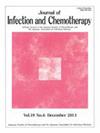Association of doses based on body constitutional parameters with the efficacy of micafungin in candidemia
IF 1.9
4区 医学
Q3 INFECTIOUS DISEASES
引用次数: 0
Abstract
Background
Invasive candidiasis is a life-threatening infection associated with high mortality, necessitating early and effective treatment. Micafungin, an echinocandin, is recommended as initial therapy for invasive candidiasis. However, the optimal micafungin dose relative to patients’ body constitutional parameters (BCPs) remains unclear. This study aimed to evaluate the relationship between the dose of micafungin per BCPs (Dose/BCPs) and treatment outcomes.
Methods
This two-center retrospective study included patients treated with micafungin who had confirmed positive blood cultures for Candida species between January 1, 2010, and December 31, 2020. We assessed the association between Dose/BCP and treatment success, as well as time to recovery following micafungin therapy.
Results
Eighty-three patients were included in the analysis, with a median age of 78 years. The primary isolated Candida species were Candida albicans (n = 34), Candida parapsilosis (n = 19), and Candida glabrata (n = 16). The treatment success rate was 44.6 % and was significantly associated with age ≥75 years. Although no significant differences in Dose/BCP were observed between the success and failure groups, patients with a Dose/BSA ≥100 mg/m2 experienced a significantly shorter time to recovery with micafungin therapy.
Conclusion
Our study identified an association between Dose/BSA and the time to recovery with micafungin therapy. While some missing data, including APACHE-II scores, limit the robustness of the findings because of the retrospective design, dose adjustment to achieve Dose/BSA ≥100 mg/m2 may be beneficial in antifungal stewardship. This adjustment could reduce treatment duration with this broad-spectrum antifungal agent.
基于体质参数的剂量与米卡芬金治疗念珠菌的疗效的关系。
背景:侵袭性念珠菌病是一种危及生命的感染,死亡率高,需要早期有效治疗。Micafungin,一种棘珠菌素,被推荐作为侵袭性念珠菌病的初始治疗。然而,相对于患者身体体质参数(bcp),米卡芬净的最佳剂量仍不清楚。本研究旨在评价米卡芬净每bcp剂量(dose / bcp)与治疗结果的关系。方法:这项双中心回顾性研究纳入了2010年1月1日至2020年12月31日期间经米卡芬金治疗的念珠菌血培养证实阳性的患者。我们评估了剂量/BCP与治疗成功之间的关系,以及micafungin治疗后的恢复时间。结果:83例患者纳入分析,中位年龄为78岁。分离到的主要念珠菌种为白色念珠菌(34株)、假丝酵母菌(19株)和光秃念珠菌(16株)。治疗成功率为44.6%,且与年龄≥75岁显著相关。虽然成功组和失败组之间的剂量/BCP没有显著差异,但剂量/BSA≥100 mg/m2的患者使用米卡芬净治疗后恢复时间明显缩短。结论:我们的研究确定了剂量/BSA与米卡芬净治疗的恢复时间之间的关联。虽然一些缺失的数据,包括APACHE-II评分,由于回顾性设计限制了结果的稳健性,但剂量调整以达到剂量/BSA≥100 mg/m2可能有利于抗真菌管理。这种调整可以缩短广谱抗真菌药的治疗时间。
本文章由计算机程序翻译,如有差异,请以英文原文为准。
求助全文
约1分钟内获得全文
求助全文
来源期刊

Journal of Infection and Chemotherapy
INFECTIOUS DISEASES-PHARMACOLOGY & PHARMACY
CiteScore
4.10
自引率
4.50%
发文量
303
审稿时长
47 days
期刊介绍:
The Journal of Infection and Chemotherapy (JIC) — official journal of the Japanese Society of Chemotherapy and The Japanese Association for Infectious Diseases — welcomes original papers, laboratory or clinical, as well as case reports, notes, committee reports, surveillance and guidelines from all parts of the world on all aspects of chemotherapy, covering the pathogenesis, diagnosis, treatment, and control of infection, including treatment with anticancer drugs. Experimental studies on animal models and pharmacokinetics, and reports on epidemiology and clinical trials are particularly welcome.
 求助内容:
求助内容: 应助结果提醒方式:
应助结果提醒方式:


